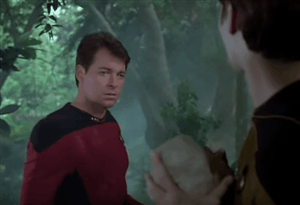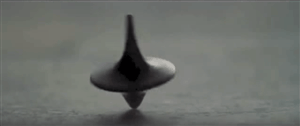VR Storytelling blog #5 – Do we need totems in virtual reality?
If virtual reality becomes better and better at mimicking reality, we might need totems to remind us what is real and what isn’t.
Virtual reality keeps becoming better at mimicking reality, or creating a new one that feels just as real. Either we show a world that looks like reality, or we create a new reality that wants to trick you into thinking it is real. Right now there are still a lot of aspects to be seen, felt and heard and they remind us that what we see isn’t real. Yet technology is developing rapidly. In time, the aspects that show the existence of the medium will become less and less present. The question is: if it would be possible to take away every aspect that reminds you the medium is there, would you want to?

How real do we want our fake worlds to be?
In the movie Inception, the characters each carry their own totem with them. This is an object that they know so completely, that the details of what it feels or looks like can tell them if they are in reality or not. The idea of being able to lose track of reality can feel scary. In horror I already know I appreciate totems for this reason. I actually had my first real nightmare in years, after watching Catatonic in VR. The experience was just a little too real for me. Something extra to remind me that it wasn’t real, might have prevented my nightmare. I never have problems with normal horror movies. I find them scary, but the fact that there is a different world beyond the borders of the screen helps. This might not have been invented as a totem. But when it wasn’t there any more, I suddenly realized that being able to see the reality outside of the screen was my totem.
So if VR keeps becoming better at mimicking reality, will we need totems in other genres also? I can imagine that being in an animated world or a world with different physics will already have aspects that remind you the reality you’re in isn’t real. Then what about a documentary or a realistic drama story? If things get real, would you still want to be placed inside a war zone? Or what about being put in a private setting with someone sitting in front of you crying? When will things get too real to handle? If people get uncomfortable they might take off the headset and stop watching. This is something to think about when making VR.

If this totem from Inception stops spinning, you’ll know you’re in the real world
Say you decide your VR projects needs some sort of totem. How could you integrate such a thing in an elegant way? In time we will be able to get rid of most of the aspects that remind us the medium exists. These aspects are called hypermediate elements. Like seeing pixels, feeling the weight of the headset or feeling the wire that attaches you to the computer. Getting rid of them is what will make VR look and feel more real. I’ve written about hypermediacy before in my previous blog posts, if you’re interested in more examples. The point is: the fact that we can leave out hypermediate elements doesn’t mean we have to. If we use them as an element of the story we are telling, these aspects can become useful. They can become totems, may we need them.
I’ve been experimenting with this idea. A result of this can be seen in a production I’ve worked on, which was launched last week. Inside the app ‘White Spots‘ is a VR cardboard film about Marit, a girl who is allergic to radiation. She stopped going to school and flew to Lage Mierden in the Netherlands, where there is little cell reception and no wifi. Now she lives with her parents in a small caravan that blocks radiation. She has little to no contact with anyone her age. With the VR experience you get to be with her, at this place where she is so alone.
The app White Spots is totally in English and can be downloaded for both Android and Iphone.
Because the film is to be viewed in Google Cardboard, it already contains many elements that remind you the medium is there. So what we did is to emphasize it even more and make it part of the story. We wanted to make you feel like you were there, but also make you realise that you are not. The reason for this was that we wanted to emphasize Marit’s loneliness, while still making you feel close to her so you can relate to her story. Marit likes to draw portraits of people, so we let her draw the camera. To do this she looks right at you, but doesn’t exactly see you. Not as a person. She even pulls the camera a bit closer for a better view at it. In the scène after that you can see the shadow of the camera. All of this emphasizes her loneliness, because even you are not really there. Yet at the same time your presence isn’t totally denied. You won’t feel like a ghost. The fact that the medium is there is now part of the story. The presence of the camera, together with seeing pixels, stitches and delay, has become your totem.
This blog post was the last one of a serie of blog posts. Follow me on Medium to read previous posts and the next series. Thank you for reading!